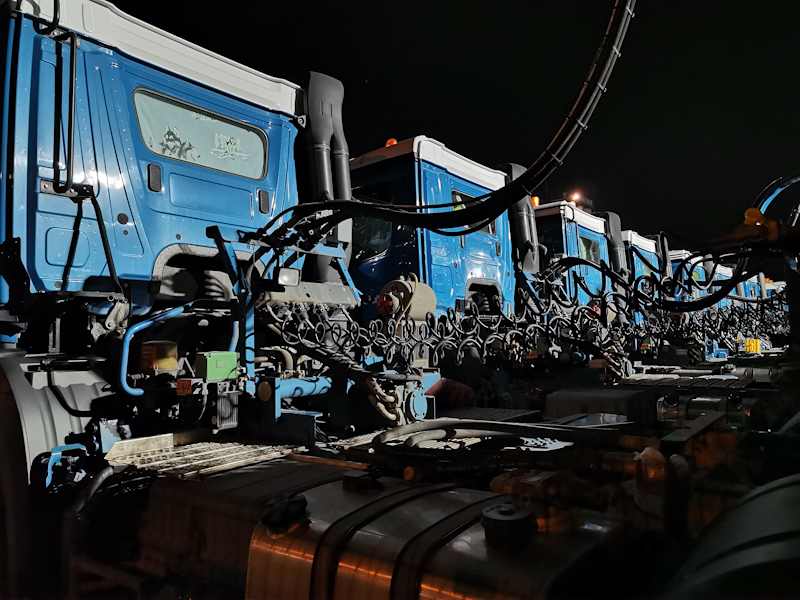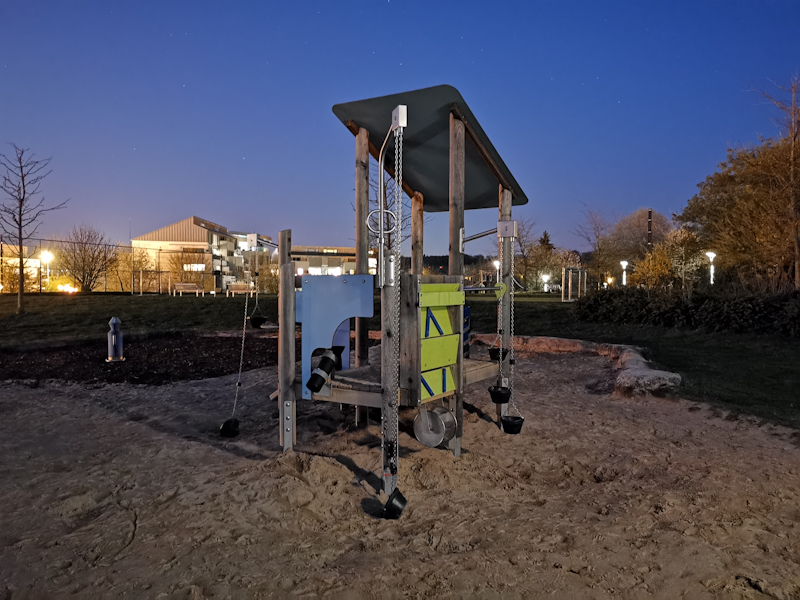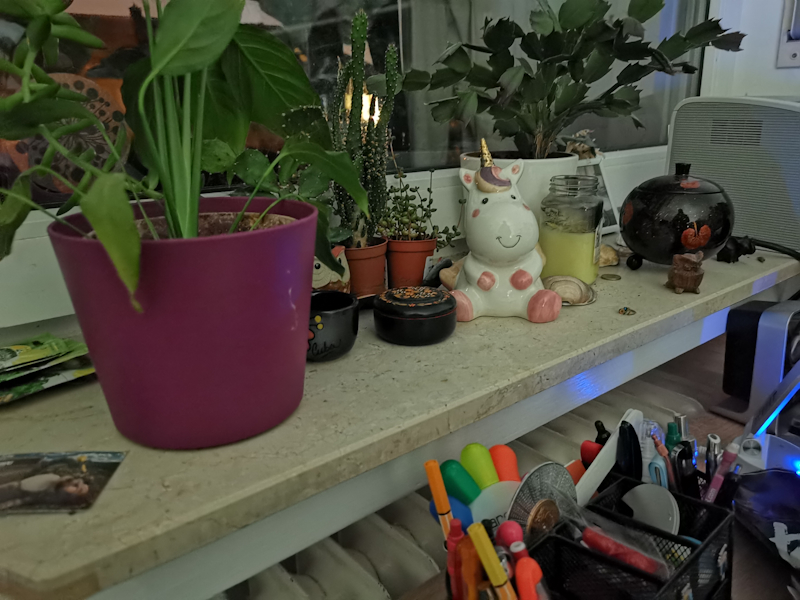The Huawei P30 & P30 Pro Reviews: Photography Enhanced
by Andrei Frumusanu on April 18, 2019 9:00 AM EST- Posted in
- Mobile
- Smartphones
- Huawei
- P30
- P30 Pro
Camera - Low Light Evaluation
Low-light photography is where Huawei’s strengths lie. Starting with the P20 the company was a pioneer in terms of computational photography, not only was the company able to improve low-light capture on smartphones with “regular” camera sensors, it also marked the start of customised camera sensor hardware that was able to achieve much higher ISO sensitivity than any other phone camera on the market.
Huawei’s rationale for adopting the RYYB sensor was in order to improve the low-light capabilities of the phone, promising 30% increased light capture. The P30 Pro in particular we’re expecting some massive low-light capture improvements, not only due to the new sensor but also thanks to the wider aperture as well as the integration of OIS in the sensor – something we haven’t seen in Huawei devices in several years.

[ P30 Pro ] - [ P30 ]
[ P20 Pro ] - [ P20 ] - [ Mate 20 Pro ]
[ S10+ (S) ] - [ S10+ (E) ] - [ S9+ (S) ]
[ G8 ] - [ G7 ] - [ V40 ]
[ View20 ] - [ OnePlus 6T ] - [ Pixel 3 ] - [ iPhone XS ]
As a note, shooting in 40MP mode in low light is pretty much a futile exercise, as the sensor just isn’t able to capture enough light without help of pixel binning down to 10MP.
Huawei had already a lead in low-light capture with its previous devices, and the only viable competition was the new Pixel’s Night Sight mode. With the P30s, Huawei now extends this lead. While not exactly reaching the level of detail on the Pixel 3’s Night Sight mode, the P30s both show very large improvements over their 40MP predecessors all while being leagues ahead of other traditional camera sensors.
It’s to be noted the Pixel 3’s Night mode was way off in terms of colour temperature, and the Huawei phones had a more correct representation of the orange illumination of sodium street lamps.
At certain brightness levels such as in this scene, Night mode on the Huawei phones can have a detrimental effect and results in blurred details, even though it produces a brighter image.
Both wide angle modules struggle in low-light, however Night mode can help out a lot. Again between the four wide angle shots between the P30 Pro and P30 we’re getting very different results, with the smaller P30 producing brighter results for some reason.

[ P30 Pro ] - [ P30 ]
[ P20 Pro ] - [ P20 ] - [ Mate 20 Pro ]
[ S10+ (S) ] - [ S10+ (E) ] - [ S9+ (S) ]
[ G8 ] - [ G7 ] - [ V40 ]
[ View20 ] - [ OnePlus 6T ] - [ Pixel 3 ] - [ iPhone XS ]
In this parking lot, again in regular shooting mode the P30s are ahead of the competition, with the only real contender being Google Night mode. Switching on the P30’s we see better exposure and shadows, although Google continues to retain a detail lead.
On the wide-angle camera, Huawei’s Night mode remains unchallenged. LG’s G8 comes near in terms of exposure, however it lacks details and is very noisy. Samsung’s new cameras are lagging far behind in this aspect.

[ P30 Pro ] - [ P30 ] - [ P20 Pro ] - [ P20 ]
[ Mate 20 Pro ] - [ S10+ (S) ] - [ S10+ (E) ] - [ S9+ (S) ]
[ G8 ] - [ G7 ] - [ V40 ] - [ View20 ]
[ OnePlus 6T ] - [ Pixel 3 ] - [ iPhone XS ]
This shot is quite challenging due to the high dynamic range between the illuminated truck cabins and the dark lower parts of the image. In the default mode, both P30s produced too dark images with not sufficient dynamic range, however on the P30 Pro the phone captures an evident HDR processed picture. I didn’t do anything special between takes, and this is something I’ve experienced in the past with Huawei devices. Unfortunately the phone has like a dozen capture modes which get triggered depending by scene, and one has little control over it and the result can only be determined by the resulting EXIF information in the image.
When in Night mode, the P30’s produce better shadows than the Pixel, however the latter continues to have an advantage in terms of detail. The Pixel is also a tad too saturated with the blue of the trucks, while the Huawei phones are too undersaturated.
Camera - Extreme Low-Light Evaluation
Moving on to extreme low-light conditions, these are scenarios we traditionally didn’t expect smartphones cameras to be effective at all. Most phones here will produce a dark image and are at their limit in terms of light capture. To be able to perform here, you need help of specialised sensors or sneaky computational photography.

[ P30 Pro ] - [ P30 ] - [ P20 Pro ] - [ P20 ]
[ Mate 20 Pro ] - [ S10+ (S) ] - [ S10+ (E) ] - [ S9+ (S) ]
[ G8 ] - [ G7 ] - [ V40 ] - [ View20 ]
[ OnePlus 6T ] - [ Pixel 3 ] - [ iPhone XS ]
In our playground shot in the night, the P30 Pro pulls in some incredible amount of light. The auto shot comes in at ISO25600, however due to the noise reduction you’re hard to notice any noise at all.
The smaller P30 had issues in terms of focusing correctly, and thus it resulted in a blurry shot.
Switching on Night mode, the P30 Pro is able to capture some outstanding results far ahead of any other device. The inclusion of OIS on the P30 Pro really augments the Night mode, and while in past devices we saw more blurred details in this mode, on the P30 Pro things actually get a lot sharper.
The Pixel 3’s Night mode can’t keep up here as even if it’s algorithmically superior, the sensor just isn’t able to capture enough input data.
Comparing the P30 Pro to say the iPhone XS really showcases the massive differences that we’re currently seeing in the competitive landscape, and the differences are absurd.

[ P30 Pro ] - [ P30 ] - [ P20 Pro ] - [ P20 ]
[ Mate 20 Pro ] - [ S10+ (S) ] - [ S10+ (E) ] - [ S9+ (S) ]
[ G8 ] - [ G7 ] - [ V40 ] - [ View20 ]
[ OnePlus 6T ] - [ Pixel 3 ] - [ iPhone XS ]
In this last in-door shot, the absurdity continues as the P30s are just in a different league. Again between the P30 Pro and the P30 we see the former take advantage of OIS and a resulting sharper picture.
Both phones in the auto mode area already ahead of the pack in terms of capture ability, but turning on the Night mode further widens the gap, achieving even more detail. I was actually aghast to see how natural the resulting image was, yet the actual room was much darker than what’s represented here.
P30 Pro & P30 Low-Light Evaluation Conclusion
Overall, Huawei here hit it out of the park in terms of low-light capture. The new sensors as well as the new optics on the P30 Pro really put the devices far ahead of the curve in terms of what they’re able to produce.
OIS for the P30 Pro in particular has notable benefits, especially when paired together with the Night mode. Huawei’s processing for Night mode is a lot brighter than previous devices. Google still seems to have the better algorithms and resulting Night Sight pictures can be a lot sharper and more detailed than Huawei’s Night mode, however under a certain threshold of low light even the Pixel 3 can’t keep up with Huawei’s new camera modules.
The P30 Pro is the best low-light camera smartphone on the market, with the P30 closely following behind. The competition really needs to scramble to improve their computational photography abilities, and be at least be able to match Google’s implementation. If we’ll see other vendors employ special sensors such as employed by Huawei is to be seen, but for now the company’s cameras are in a class of their own in low-light.










85 Comments
View All Comments
boozed - Friday, April 19, 2019 - link
Yeah nahs.yu - Thursday, April 18, 2019 - link
https://1drv.ms/u/s!Apr9zBuBUufHgaMUssv4Mh1vuyVh0gThis is P30P's often bragged about "50x zoom" at default magnification i.e. "zoomed out" vs. a 1" at "8x" zoom at 100% magnification. So you see with a premium compact like the Sony RX100IV or even a cheap one like Panasonic's ZS110 your *real optical* zoom combined with cropping could get you over "100x zoom" in Huawei's terms of usability.
Huawei could get you 5x but that's also worse than the 1" results notable at a glance except I forgot to make a screenshot of that.
Compacts are not dead.
s.yu - Thursday, April 18, 2019 - link
Typo, I meant the RX100VI.Quantumz0d - Thursday, April 18, 2019 - link
First thank you for posting that RX100 series shot. Some people think that real cameras are dead because of smartphones and their SW Gimmicks. The HW limitations truly show their stand. Not even Sony RX but even the old legend Nokia Pureview 808 or the Lumia 1020 have real purpose massive sensor with Xenon flash.Its a shame how so many cameras are being tacked on for marketing purposes, esp that night mode which kills the natural scene with over exposed unnaturally lit shot, a fake perception and deception.
boozed - Friday, April 19, 2019 - link
I thought the best part was the mainstream media fearmongering about the phone because of its "50x zoom". As if this is the first device to have a long focal length.s.yu - Friday, April 19, 2019 - link
It may be the first phone to allow 10x digital crop directly in the camera app though...?crotach - Tuesday, April 23, 2019 - link
DSLR has nothing to fear from these phones, it's a completely different world. MILC is taking care of the death of DSLR, but it will be a long and arduous death.Phones like these are responsible for the death of small compact cameras. These days I only see people buying the compact shooters for their kids, because they're much cheaper than a flagship phone. Give it a few more years and I doubt you'll find many compact cameras in the shops.
katsetus - Thursday, April 18, 2019 - link
Next time I'm planning a vacation, I'll keep Luxembourg in mind.Speedfriend - Thursday, April 18, 2019 - link
Apple is just so far behind in the camera now. Although having bought a P30 Pro, its speed in everyday use seems no faster and possibly slower than my Pixel 2 XL was. Battery life is insane though. Whereas my Pixel 2 XL was dead by the evening, the P30 Pro can make it to the next afternoonstar-affinity - Thursday, May 9, 2019 - link
At least the Iphones has video recording using 4K@60fps and the colours tend to be more natural compared to the P30 Pro in the comparisons I've seen. But sure the P30 Pro has many other advantages such as that nsane zoom and great low light performance.